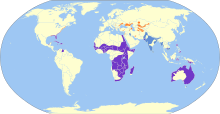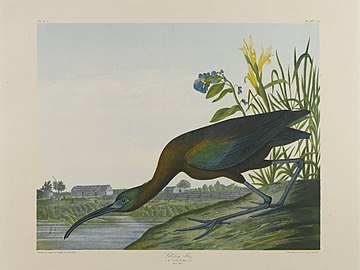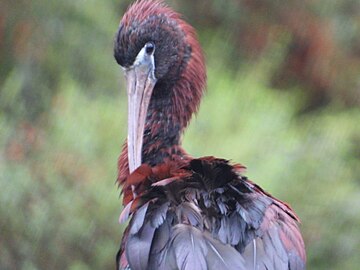彩鹮
| 彩鹮 | |
|---|---|

| |
| 非繁殖羽 | |

| |
| 繁殖羽 | |
| 科学分类 | |
| 界: | 动物界 Animalia |
| 门: | 脊索动物门 Chordata |
| 纲: | 鸟纲 Aves |
| 目: | 鹈形目 Pelecaniformes |
| 科: | 䴉科 Threskiornithidae |
| 属: | 彩鹮属 Plegadis |
| 种: | 彩鹮 P. falcinellus
|
| 二名法 | |
| Plegadis falcinellus | |

| |
| 彩鹮的分布範圍 繁殖區 遷徙區 留鳥 非繁殖區
| |
| 異名 | |
| |

彩鹮(学名:Plegadis falcinellus)为鹮科彩鹮属的鸟类。其學名源自古希臘語plegados及拉丁語falcis,意指「鐮刀」,這是指其喙的獨特形狀。[3]
分佈
[编辑]這是分佈最廣的伊比斯種類,在歐洲、亞洲、非洲、澳洲,以及美洲大西洋和加勒比地區的溫暖地區繁殖。[4][5] 據信它起源於舊大陸,並在19世紀從非洲自然擴散到南美洲北部,之後擴散到北美洲。彩䴉首次在新大陸被記錄是在1817年(新澤西州)。奧杜邦在1832年僅在佛羅里達見過一次該物種。在1940年代,這種鳥類的分佈範圍大幅向北擴展,在1980年代向西擴展。[6] 這個物種是遷徙性的;大多數歐洲的鳥在冬季會飛往非洲,而在北美洲,北卡羅來納以北的鳥在冬季會飛往更南的地區。[7] 雖然通常被懷疑是印度的遷徙物種,但彩䴉在印度西部是留鳥。[8] 其他群體的鳥類可能在繁殖季節之外廣泛散佈。它在歐洲的數量正在增加。[1] 在西班牙本為常見繁殖鳥,但在20世紀早期消失,後在1993年又重新發現,並在幾個聚落迅速增加到數千對。[9] 它也在法國迅速建立了快速增長的繁殖聚落,該國在2000年代之前幾乎沒有繁殖記錄。[10] 在西北歐,越來越多的非繁殖訪客被觀察到,這個地區歷史上彩䴉的記錄非常罕見。[11] 例如,在英國和愛爾蘭過冬的彩䴉,似乎有增長的趨勢,2010年至少有22次觀察到。[12] 2014年,一對鳥在林肯郡嘗試繁殖,這是英國的第一次嘗試。[13] 英國第一次成功繁殖是一對在劍橋郡繁殖,並在2022年孵化出一隻幼鳥。[14] 現在一些個體大多在夏季停留在愛爾蘭,但目前沒有繁殖的證據。在新西蘭,每年都有少數個體到達,主要在7月;最近有一對在皇家琵鷺的聚落中繁殖。[15] 彩䴉自1930年代以來一直是澳大利亞的繁殖物種。[16] 在印度,它們現在是繁殖物種,現在可以在農業區、竹林森林區與其他群居繁殖的水鳥一起築巢。[17][18] 長期研究還顯示,彩䴉在印度西部的農業濕地和被淹的農田中覓食。[8]
在中国大陆分佈於上海、浙江、福建、广东等地,主要生活于栖息在湖沼间。2009年起,中国大陆大部分地区时常出现彩鹮的身影,其中包括新疆,云南,河北,内蒙古,浙江,四川等地。
行為
[编辑]彩䴉在繁殖後會向外擴散,具有高度漫遊習性。較北的群體是完全遷徙的,並在廣闊的前線上遷徙,例如穿越撒哈拉沙漠。環繞黑海沿岸的彩䴉似乎更喜歡在薩赫爾和西非過冬,在裏海沿岸的則被發現遷徙到東非、阿拉伯半島,甚至遠至巴基斯坦和印度。[19] 印度西部的彩䴉數量季節性變化顯著,冬季和夏季數量最多,在季風季節急劇減少,可能顯示它們做區域性移動以找到合適的繁殖地點。[8] 溫帶地區的群體在當地春季繁殖,而熱帶地區的群體在雨季繁殖。繁殖時通常與各物種混居。當不繁殖時,遷徙期間、冬季或旱季,該物種通常以小群體覓食,並在夜間與其他物種一起群居在樹上過夜,這些樹可能距離濕地覓食區有一定距離。
棲地
[编辑]彩䴉在非常淺的水中覓食,並在有高大且密集的挺水植被(如蘆葦、紙莎草(或燈心草))及低矮樹木或灌木的淡水或半鹹水濕地築巢。牠們偏好湖泊和河流邊緣的沼澤地,但也能在潟湖、洪泛平原、濕草地、沼澤、水庫、污水池、稻田和灌溉農田中找到。在使用印度西部的農田時,彩䴉顯示出季節性地依賴景觀的使用。在夏季,牠們偏好使用>200公頃的濕地區域,而在其他季節則使用中等數量的濕地(50-100公頃)區域,但不一定在濕地中覓食。[8] 在沿海地區,如河口、三角洲、鹽沼和沿海潟湖中較少見。偏好的棲地通常是在遠離覓食區的大樹上。當沒有人的干擾時,牠們甚至會在城市中棲息,利用繁忙公路和其他道路旁的樹木。[20]
繁殖
[编辑]巢通常由樹枝和植被構成的平台,位置至少在距水面1米(3.3英尺)處,有時高達7米(23英尺),位於密集的挺水植被、低矮樹木或灌木中。3到4顆蛋(偶爾5顆)會被產下,由雄鳥和雌鳥共同孵化,時間為20至23天。幼鳥約7天後可以離巢,但父母會繼續餵養牠們6至7週。幼鳥大約在28天後會長羽。[1]
飲食
[编辑]彩䴉的飲食會根據季節變化,且非常依賴於可用的食物。獵物包括昆蟲成蟲和幼蟲,如水生甲蟲、蜻蜓、豆娘、蚱蜢、蟋蟀、蒼蠅和石蠅,環節動物包括水蛭、軟體動物(例如蝸牛和貽貝)、甲殼類(例如螃蟹和小龍蝦),偶爾也會捕食魚、兩棲動物、蜥蜴、小蛇和幼鳥。[1]
描述
[编辑]這個物種是中型的䴉。牠體長48—66 cm(19—26英寸),平均約59.4 cm(23.4英寸),翼展80—105 cm(31—41英寸)。[21][22] 喙長度為9.7至14.4 cm(3.8至5.7英寸),每隻翅膀長度為24.8—30.6 cm(9.8—12.0英寸),尾巴長9—11.2 cm(3.5—4.4英寸),跗跖骨長度為6.8—11.3 cm(2.7—4.4英寸)。[22] 這種䴉的體重範圍從17.041公克不等。[22] 繁殖期成鳥有紅褐色的身體和閃亮的瓶綠色翅膀。非繁殖的成鳥和幼鳥身體顏色較暗淡。這種鳥的喙呈褐色,面部皮膚為暗色,上下邊緣有藍灰色(非繁殖期)至鈷藍色(繁殖期)的邊界,腿部為紅褐色。與鷺類不同,伊比斯飛行時頸部伸直,飛行姿態優雅,通常呈V形隊列飛行。牠們的羽毛也閃閃發亮。
這種相對安靜的伊比斯發出的聲音包括各種的低吼聲和咕嚕聲,包括在繁殖時發出的沙啞grrrr聲。
保育
[编辑]彩䴉是適用於非洲-歐亞遷徙水鳥保護協定(AEWA)的物種之一。彩䴉可能因濕地棲地退化和因排水、海水倒灌、地下水抽取及外來植物入侵而造成的損失而受到威脅。[1]
中国国家重点保护动物等级:一级
亚种
[编辑]圖庫
[编辑]-
觅食。 巴塞罗那
-
彩䴉, 約翰·詹姆斯·奧杜邦, 布魯克林博物館
-
蛋, 收藏於威斯巴登博物館
-
攝於澳洲維多利亞
参考文献
[编辑]- ^ 1.0 1.1 1.2 1.3 1.4 BirdLife International. Plegadis falcinellus. The IUCN Red List of Threatened Species 2019. [1 October 2016]. 資料庫資料包含說明此物種被編入無危級別的原因
- ^ 中国科学院动物研究所. 彩鹮. 《中国动物物种编目数据库》. 中国科学院微生物研究所. [2009-04-04]. (原始内容存档于2016-03-05).
- ^ Jobling, James A. The Helm Dictionary of Scientific Bird Names. London: Christopher Helm. 2010: 157, 310. ISBN 978-1-4081-2501-4.
- ^ Olson, S.L.; James, H.F.; Meister, C.A. Winter field notes and specimen weights of Cayman Island birds. Bulletin of the British Ornithologists' Club. 1981, 101: 339–346 [2024-08-07]. ISSN 0007-1595. (原始内容存档于2013-06-29).
Wetmore observed an adult and an immature with herons in the West Bay district, 3 February 1972. Johnston et al. (1971) list but one sighting on GC (Grand Cayman) and 2 on CB (Cayman Brac).
- ^ Santoro, Simone; Sundar, K.S.G.; Cano-Alonso, L.S. Glossy Ibis ecology and conservation. SIS Conservation. 2019, 1: 1–148. ISBN 978-2-491451-01-1.
- ^ Patten, Michael A.; Lasley, Greg W. Range Expansion of the Glossy Ibis in North America (PDF). North American Birds: 241–247. [2024-08-07]. (原始内容存档 (PDF)于2023-11-15).
- ^ Taft, Dave. Glossy Ibises Are Like 21st-Century Pterodactyls. The New York Times. 28 June 2013 [29 June 2013]. (原始内容存档于2014-12-06).
- ^ 8.0 8.1 8.2 8.3 Sundar, K.S.G.; Kittur, S. Glossy Ibis Distribution and Abundance in an Indian Agricultural Landscape: Seasonal and Annual Variations (PDF). SIS Conservation. 2019, 1: 135–138 [2024-08-07]. (原始内容存档 (PDF)于2024-03-01).
- ^ Máñez, M.; et al. Twenty two years of monitoring of the Glossy Ibis Plegadis falcinellus in Doñana. SIS Conservation. 2019, 2019: 98–103.
- ^ Champagnon, J.; et al. The Settlement of Glossy Ibis in France. SIS Conservation. 2019, 2019: 50–55.
- ^ Rykind af sorte ibisser i danske vådområder. Danish Ornithological Society. 20 May 2022 [28 January 2023]. (原始内容存档于2023-05-17) (丹麦语).
- ^ Hudson N. & the Rarities Committee. Report on Rare Birds in Great Britain. British Birds. 2010, 104: 557–629.
- ^ Glossy ibis in nest attempt at Frampton Marshes. BBC News. 18 August 2014 [2024-08-07]. (原始内容存档于2023-11-14).
- ^ Glossy Ibis breeds in Britain for first time. BirdGuides. 13 September 2023 [27 September 2023]. (原始内容存档于2024-03-04).
- ^ Glossy ibis Plegadis falcinellus (Linnaeus, 1766). New Zealand Birds Online. [16 January 2019]. (原始内容存档于2024-05-21).
- ^ Bailey, R. F. New Nesting Records of Glossy Ibis. Emu - Austral Ornithology. 1934, 33 (4): 279–291. Bibcode:1934EmuAO..33..279B. ISSN 0158-4197. doi:10.1071/MU933279 (英语).
- ^ Tiwari, J. K.; Rahmani, A. R. Large heronries in Kutch and the nesting of Glossy Ibis Plegadis falcinellus at Luna jheel, Kutch, Gujarat, India. Journal of the Bombay Natural History Society. 1998, 95: 67–70.
- ^ Ranade, Sachin; Ranade, Sonali; Banajyoti, Nath; Saikia, Prasanta Kumar; Prakash, Vibhu. Recent breeding record and parental care behaviour of Glossy Ibis Plegadis falcinellus in the Assam state, India (PDF). SIS Conservation. 2021, 3: 13–18 [2024-08-07]. (原始内容存档 (PDF)于2024-03-30).
- ^ Santoro, S.; Champagnon, J.; Kharitonov, S.P.; Zwarts, L.; Oschadleus, H.D.; Manez, M.; Samraoui, B.; Nedjah, R.; Volponi, S.; Cano-Alonso, L.S. Long-distance Dispersal of the Afro-Eurasian Glossy Ibis From Ring Recoveries (PDF). SIS Conservation. 2019, 1: 139–146 [2024-08-07]. (原始内容存档 (PDF)于2023-05-20).
- ^ Mehta, Kanishka; Koli, Vijay K.; Kittur, Swati; Gopi Sundar, K. S. Can you nest where you roost? Waterbirds use different sites but similar cues to locate roosting and breeding sites in a small Indian city. Urban Ecosystems. 2024, 27 (4): 1279–1290. Bibcode:2024UrbEc.tmp...13M. ISSN 1573-1642. doi:10.1007/s11252-023-01454-5 (英语).
- ^ Glossy ibis videos, photos and facts – Plegadis falcinellus. ARKive. [5 March 2013]. (原始内容存档于2013-03-27).
- ^ 22.0 22.1 22.2 Hancock, James A.; Kushan, James A.; Kahl, M. Philip. Storks, Ibises, and Spoonbills of the World. Academic Press. 1992. ISBN 978-0-12-322730-0.
- ^ 中国科学院动物研究所. 彩鹮指名亚种. 《中国动物物种编目数据库》. 中国科学院微生物研究所. [2009-04-04]. (原始内容存档于2013-12-03).
| ||||||||||||
Text is available under the CC BY-SA 4.0 license; additional terms may apply.
Images, videos and audio are available under their respective licenses.








